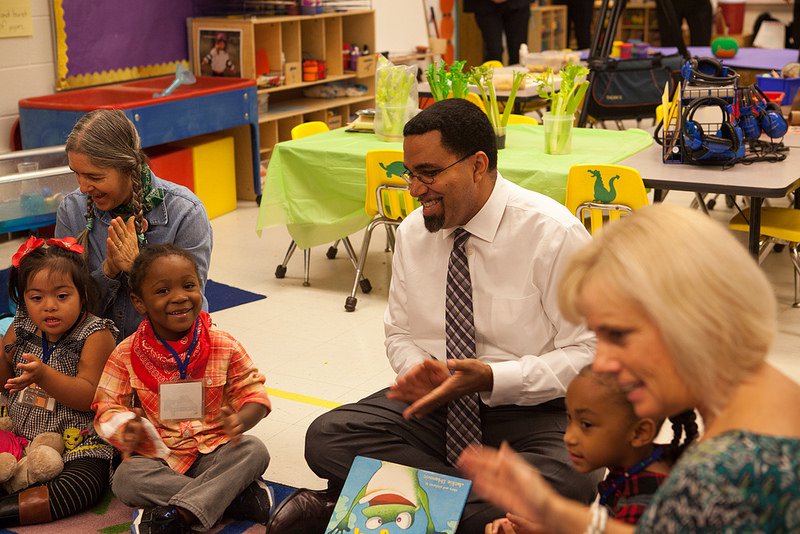New Guidance on Using ESSA to Support Early Learning
Blog Post

Flickr (https://www.flickr.com/photos/departmentofed/30204592410/)
Oct. 26, 2016
Last Thursday in Charleston, West Virginia, U.S. Education Secretary John King laid out the Obama Administration’s vision for early childhood education with the release of early learning guidance for the Every Student Succeeds Act (ESSA), emphasizing a continuum of high-quality learning that spans from birth through third grade. He explained that strong programs serving children from birth through pre-K must be followed by high-quality full-day kindergarten as well as strong instructional practices in first through third grade. King explained that, “A high-quality early education can support social emotional development and unlock a child’s potential, so that all children have the foundation they need to thrive in school and beyond.”
The release of the U.S. Department of Education’s early learning non-regulatory guidance on the implementation of ESSA will help states and local education agencies (LEAs) emphasize early childhood programs and the early elementary grades in their education plans. Former iterations of ESSA (including No Child Left Behind) allowed funds to be used to support children prior to kindergarten entry, but very few states and LEAs used federal funds for this purpose in the past. In fact, Title I funds serve only about 3 percent of children under age five. New provisions under ESSA and this accompanying guidance will hopefully be the encouragement needed to strengthen pre-K and the early grades. The guidance highlights three areas states and LEAs can do so: 1) expanding access to high-quality; 2) fostering better alignment, collaboration, and coordination birth-through-third grade; and 3) supporting educators.
ESSA can be used to expand access to high-quality early learning programs for children with special needs, dual language learners, children experiencing homelessness, and other special populations of young children. As before, LEAs with pre-K programs supported by Title I funding are required to meet Head Start Performance Standards. The guidance clarifies, however, that Title I preschool programs do not need to adopt the entire set of standards. They must meet at minimum the education standards found in Head Start Program Performance Standards and the Head Start Child Early Learning Outcome Framework in order to ensure high standards across settings.
States and LEAs can also use ESSA to foster better alignment, collaboration, and coordination horizontally (between early childhood programs in different settings) and vertically (bridging birth to five-year-old programs and the K-12 systems together). The coordination and alignment of state longitudinal data systems, standards, assessment, and curriculum are vital to ensuring that children experience a seamless progression of learning through the early years and grades. State education agencies are encouraged to coordinate all early learning programs including child care subsidized through the Child Care Development Fund, Head Start, early interventions funded through the Individuals with Disabilities Education Act, and Title I pre-K (if the state offers it). LEAs must develop formal agreements with Head Start and are encouraged to also do so with other early care and education programs. In the past, the onus has been on Head Start and other early learning providers to reach out to school districts and create agreements and forge relationships. Now, all stakeholders across settings have additional incentives to work together to better serve children and families.
Additionally, ESSA requires states and LEAs to include the number and percentage of children enrolled in preschool programs on report cards, which will help build transparency around efforts to serve children prior to kindergarten entry. This can help states evaluate how and if they are serving all of the different demographics of young children in their state. More guidance will be coming that will hopefully answer questions like whether states and LEAs will have to report the number and percentage of both three- and four-year-olds served.
And state and LEA leaders can use ESSA to support educators (principals, teachers, and administrators) to build their child development knowledge and skills across all of the learning domains. So states could revamp their principal preparation, for instance, to help principals have a better understanding of how to serve as instructional leaders for teachers of pre-K and the early grades.
States and LEAs can use funds available under Titles I, II, and III of ESSA for professional development to support high-quality teaching in both school and other early childhood settings. Common professional development will enable all the adults working with children birth through age eight to have the ability to form horizontal and vertical alignment around instruction.
Most of the early learning provisions in ESSA are discretionary and state and LEA leaders have many priorities. But improving children’s educational experiences in the early years and grades should be high on the list. The Department’s guidance offers some ideas and resources for how to use federal education dollars to support these efforts, but it’s up to state and local leaders to make sure the focus on young learners makes it into their plans.